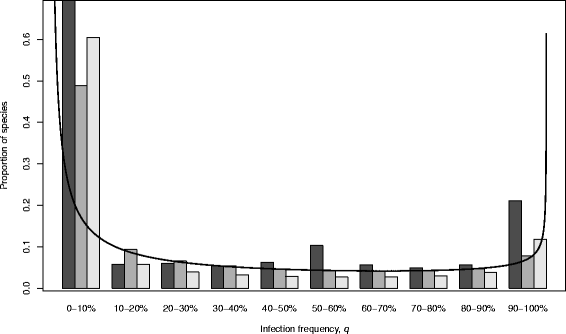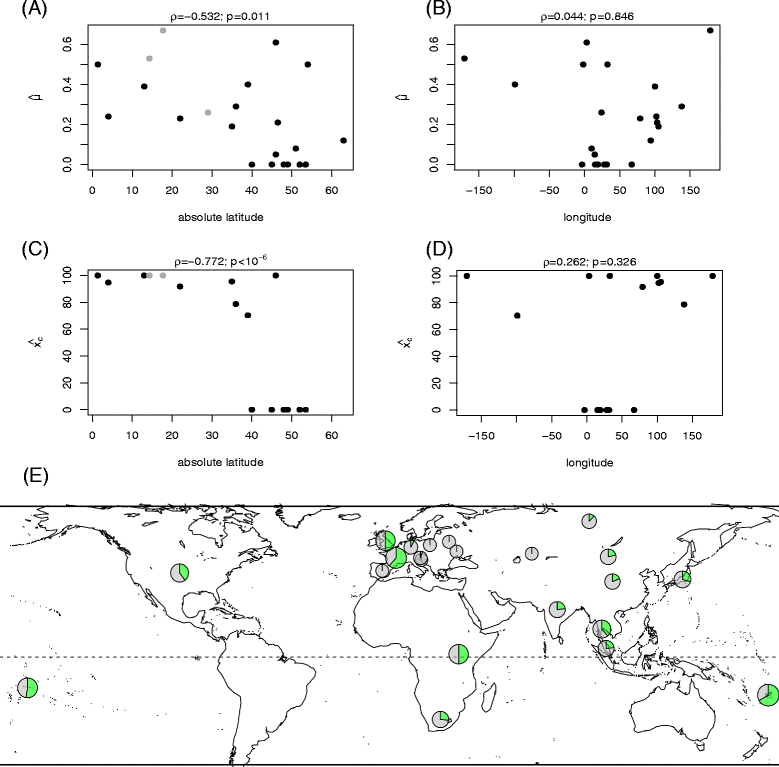Wolbachia in butterflies and moths: geographic structure in infection frequency
- PMID: 26180539
- PMCID: PMC4502936
- DOI: 10.1186/s12983-015-0107-z
Wolbachia in butterflies and moths: geographic structure in infection frequency
Abstract
Introduction: Butterflies and moths (Lepidoptera) constitute one of the most diverse insect orders, and play an important role in ecosystem function. However, little is known in terms of their bacterial communities. Wolbachia, perhaps the most common and widespread intracellular bacterium on Earth, can manipulate the physiology and reproduction of its hosts, and is transmitted vertically from mother to offspring, or sometimes horizontally between species. While its role in some hosts has been studied extensively, its incidence across Lepidoptera is poorly understood. A recent analysis using a beta-binomial model to infer the between-species distribution of prevalence estimated that approximately 40 % of arthropod species are infected with Wolbachia, but particular taxonomic groups and ecological niches seem to display substantially higher or lower incidences. In this study, we took an initial step and applied a similar, maximum likelihood approach to 300 species of Lepidoptera (7604 individuals from 660 populations) belonging to 17 families and 10 superfamilies, and sampled from 36 countries, representing all continents excluding Antarctica.
Results: Approximately a quarter to a third of individuals appear to be infected with Wolbachia, and around 80 % of Lepidoptera species are infected at a non-negligible frequency. This incidence estimate is very high compared to arthropods in general. Wolbachia infection in Lepidoptera is shown to vary between families, but there is no evidence for closely related groups to show similar infection levels. True butterflies (Papilionoidea) are overrepresented in our data, however, our estimates show this group can be taken as a representative for the other major lepidopteran superfamilies. We also show substantial variation in infection level according to geography - closer locations tend to show similar infection levels. We further show that variation in geography is due to a latitudinal gradient in Wolbachia infection, with lower frequencies towards higher latitudes.
Conclusions: Our comprehensive survey of Wolbachia infection in Lepidoptera suggests that infection incidence is very high, and provides evidence that climate and geography are strong predictors of infection frequency.
Keywords: Bacteria; Butterfly; Latitudinal gradient; Moth.
Figures



References
-
- van Nieukerken EJ, Kaila L, Kitching IJ, Kristensen NP, Lees DC, Minet J, et al. Order Lepidoptera Linnaeus, 1758. Zootaxa. 2011;3148:212–21.
-
- Banziger H. Remarkable new cases of moths drinking human tears in Thailand (Lepidoptera: Thyatritridae, Sphingidae, Notodontidae) Nat Hist Bull Siam Soc. 1992;40(1):91–102.
-
- Pierce NE. Predatory and parasitic Lepidoptera: Carnivores living on plants. Journal of the Lepidopterists’ Society. 1995;49(4):412–53.
-
- Zaspel JM, Weller SJ, Branham MA. A comparative survey of proboscis morphology and associated structures in fruit-piercing, tear-feeding, and blood-feeding moths in Calpinae (Lepidoptera: Erebidae) Zoomorphology. 2011;130(3):203–25. doi: 10.1007/s00435-011-0132-1. - DOI
LinkOut - more resources
Full Text Sources
Other Literature Sources

